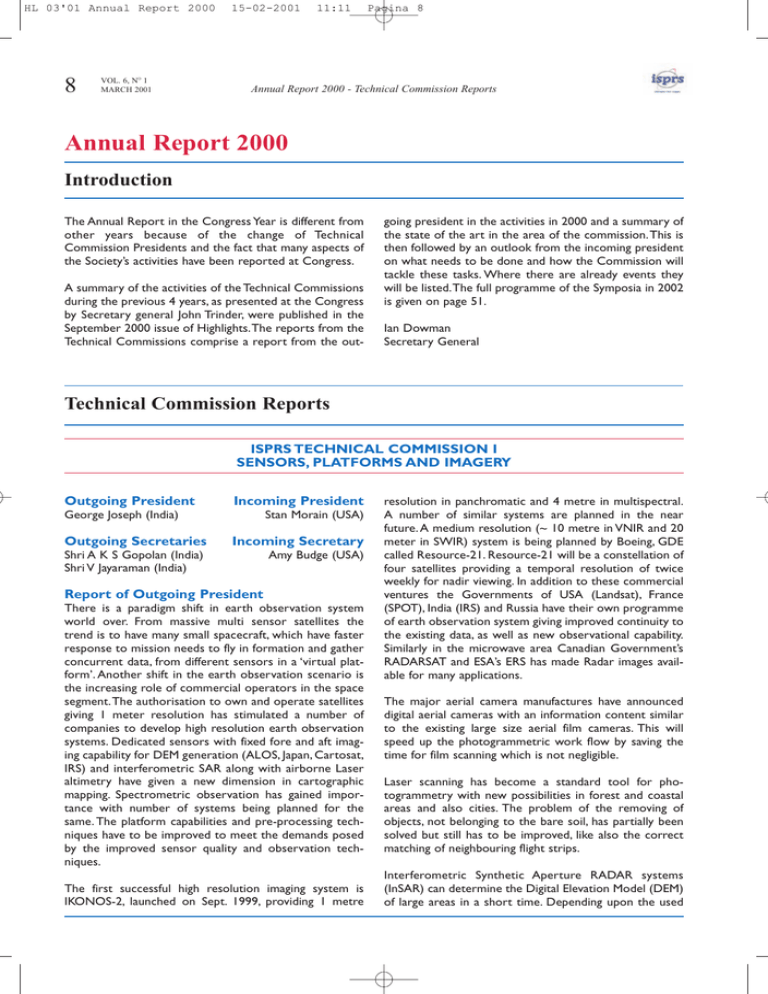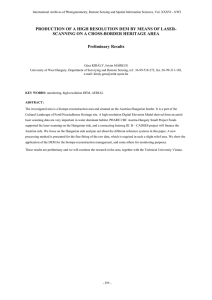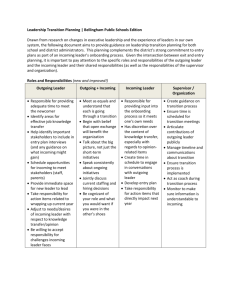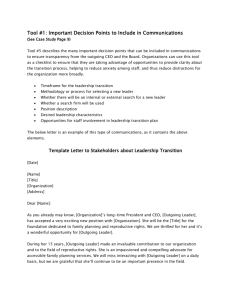Annual Report 2000 8 Introduction
advertisement

HL 03'01 Annual Report 2000 8 VOL. 6, NO 1 MARCH 2001 15-02-2001 11:11 Pagina 8 Annual Report 2000 - Technical Commission Reports Annual Report 2000 Introduction The Annual Report in the Congress Year is different from other years because of the change of Technical Commission Presidents and the fact that many aspects of the Society’s activities have been reported at Congress. A summary of the activities of the Technical Commissions during the previous 4 years, as presented at the Congress by Secretary general John Trinder, were published in the September 2000 issue of Highlights.The reports from the Technical Commissions comprise a report from the out- going president in the activities in 2000 and a summary of the state of the art in the area of the commission.This is then followed by an outlook from the incoming president on what needs to be done and how the Commission will tackle these tasks. Where there are already events they will be listed.The full programme of the Symposia in 2002 is given on page 51. Ian Dowman Secretary General Technical Commission Reports ISPRS TECHNICAL COMMISSION I SENSORS, PLATFORMS AND IMAGERY Outgoing President Incoming President George Joseph (India) Stan Morain (USA) Outgoing Secretaries Incoming Secretary Shri A K S Gopolan (India) Shri V Jayaraman (India) Amy Budge (USA) Report of Outgoing President There is a paradigm shift in earth observation system world over. From massive multi sensor satellites the trend is to have many small spacecraft, which have faster response to mission needs to fly in formation and gather concurrent data, from different sensors in a ‘virtual platform’. Another shift in the earth observation scenario is the increasing role of commercial operators in the space segment.The authorisation to own and operate satellites giving 1 meter resolution has stimulated a number of companies to develop high resolution earth observation systems. Dedicated sensors with fixed fore and aft imaging capability for DEM generation (ALOS, Japan, Cartosat, IRS) and interferometric SAR along with airborne Laser altimetry have given a new dimension in cartographic mapping. Spectrometric observation has gained importance with number of systems being planned for the same. The platform capabilities and pre-processing techniques have to be improved to meet the demands posed by the improved sensor quality and observation techniques. The first successful high resolution imaging system is IKONOS-2, launched on Sept. 1999, providing 1 metre resolution in panchromatic and 4 metre in multispectral. A number of similar systems are planned in the near future. A medium resolution (~ 10 metre in VNIR and 20 meter in SWIR) system is being planned by Boeing, GDE called Resource-21. Resource-21 will be a constellation of four satellites providing a temporal resolution of twice weekly for nadir viewing. In addition to these commercial ventures the Governments of USA (Landsat), France (SPOT), India (IRS) and Russia have their own programme of earth observation system giving improved continuity to the existing data, as well as new observational capability. Similarly in the microwave area Canadian Government’s RADARSAT and ESA’s ERS has made Radar images available for many applications. The major aerial camera manufactures have announced digital aerial cameras with an information content similar to the existing large size aerial film cameras. This will speed up the photogrammetric work flow by saving the time for film scanning which is not negligible. Laser scanning has become a standard tool for photogrammetry with new possibilities in forest and coastal areas and also cities. The problem of the removing of objects, not belonging to the bare soil, has partially been solved but still has to be improved, like also the correct matching of neighbouring flight strips. Interferometric Synthetic Aperture RADAR systems (InSAR) can determine the Digital Elevation Model (DEM) of large areas in a short time. Depending upon the used










